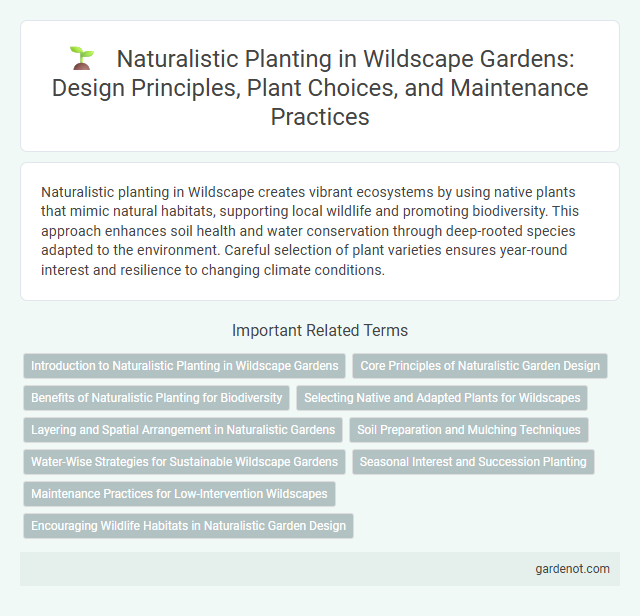Naturalistic planting in Wildscape creates vibrant ecosystems by using native plants that mimic natural habitats, supporting local wildlife and promoting biodiversity. This approach enhances soil health and water conservation through deep-rooted species adapted to the environment. Careful selection of plant varieties ensures year-round interest and resilience to changing climate conditions.
Introduction to Naturalistic Planting in Wildscape Gardens
Naturalistic planting in wildscape gardens emphasizes the use of native plants arranged in patterns that mimic natural ecosystems, promoting biodiversity and ecological balance. This approach supports local wildlife by providing food and habitat while enhancing aesthetic appeal through seasonal changes and diverse textures. Implementing naturalistic planting requires careful selection of species suited to the regional climate, soil conditions, and ecological interactions to create sustainable and self-maintaining landscapes.
Core Principles of Naturalistic Garden Design
Naturalistic planting in wildscape design emphasizes native species selection, seasonal dynamics, and ecological resilience to create sustainable habitats. Core principles include plant community composition, structural diversity, and minimal intervention to mimic natural ecosystem processes. This approach enhances biodiversity, supports pollinators, and promotes soil health through adaptive planting strategies.
Benefits of Naturalistic Planting for Biodiversity
Naturalistic planting enhances biodiversity by creating habitats that support a wide range of native flora and fauna, promoting ecological balance. This approach increases pollinator activity, including bees and butterflies, which are crucial for ecosystem health and food production. By mimicking natural ecosystems, naturalistic planting improves soil health and resilience, contributing to long-term environmental sustainability.
Selecting Native and Adapted Plants for Wildscapes
Selecting native and adapted plants for wildscapes enhances biodiversity by providing essential habitats and food sources for local wildlife. These plants are well-suited to the regional climate and soil conditions, reducing maintenance and the need for irrigation or fertilizers. Incorporating a diverse mix of species ensures ecological balance and resilience against pests and diseases.
Layering and Spatial Arrangement in Naturalistic Gardens
Naturalistic planting emphasizes layering by combining groundcovers, perennials, shrubs, and trees to create diverse vertical structure and ecological niches. Spatial arrangement follows natural patterns of plant communities, allowing species to coexist based on their light, water, and soil preferences. This approach fosters biodiversity, resilience, and dynamic seasonal interest in wildscape gardens.
Soil Preparation and Mulching Techniques
Naturalistic planting thrives on well-prepared soil enriched with organic matter to enhance structure and nutrient availability for native flora. Employing mulching techniques such as using shredded bark or leaf litter helps retain moisture, suppress weeds, and improve soil fertility over time. These practices create a sustainable environment that supports biodiversity and mimics natural ecosystems in wildscapes.
Water-Wise Strategies for Sustainable Wildscape Gardens
Naturalistic planting in wildscape gardens employs water-wise strategies that mimic native ecosystems to reduce irrigation needs while supporting biodiversity. Techniques such as selecting drought-tolerant native plants, utilizing mulch for moisture retention, and incorporating rain gardens optimize water usage and promote soil health. These sustainable approaches create resilient landscapes that thrive under local climate conditions, conserving water resources effectively.
Seasonal Interest and Succession Planting
Wildscape designs prioritize naturalistic planting by incorporating diverse native species that provide continuous seasonal interest through staggered flowering, fruiting, and foliage changes. Succession planting techniques ensure a dynamic landscape, with early bloomers transitioning seamlessly to mid- and late-season plants, maintaining habitat value and visual appeal year-round. This approach supports biodiversity by offering food sources and shelter for wildlife throughout different seasons.
Maintenance Practices for Low-Intervention Wildscapes
Naturalistic planting in wildscapes thrives with minimal intervention, emphasizing adaptive maintenance practices such as selective pruning, targeted invasive species removal, and seasonal monitoring to promote native biodiversity. Maintaining soil health through organic mulching and avoiding synthetic chemicals supports resilient ecosystems and facilitates natural regeneration. Regular observation ensures early detection of ecological imbalances, enabling timely, low-impact adjustments that preserve habitat integrity.
Encouraging Wildlife Habitats in Naturalistic Garden Design
Naturalistic planting in Wildscape gardens emphasizes native plants that provide food, shelter, and breeding grounds for local wildlife, supporting biodiversity and ecosystem health. Selecting a diverse range of species, including native grasses, flowering plants, and shrubs, creates layered habitats that attract pollinators, birds, and small mammals. Incorporating features like water sources, deadwood, and native ground covers further enhances habitat complexity, encouraging sustainable wildlife populations.
Naturalistic planting Infographic

 gardenot.com
gardenot.com